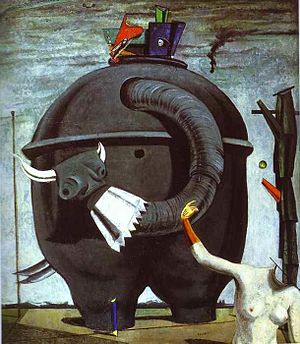The Elephant Celebes
| The Elephant Celebes | |
|---|---|
 |
|
| Artist | Max Ernst |
| Year | 1921 |
| Medium | Oil on canvas |
| Dimensions | 125.4 cm × 107.9 cm (49.4 in × 42.5 in) |
| Location | Tate Modern, London |
The Elephant Celebes (or short Celebes) is a 1921 painting by the German Dadaist and surrealist Max Ernst. It is among the most famous of Ernst's early surrealist works and "undoubtedly the first masterpiece of Surrealist painting in the de Chirico tradition." It combines the vivid dreamlike atmosphere of Surrealism with the collage aspects of Dada.
Giorgio de Chirico was an inspiration for the early Surrealists, and Celebes' palette and spatial construction show his influence. The painting also attempts to apply Dada's collage effects to simulate different materials. Ernst's realistic portrayal of the constituent elements produces a hallucinatory effect that he associated with collage, and was trying to achieve in this painting. Regarding the art of collage, Ernst said, "It is the systematic exploitation of the coincidental or artificially provoked encounter of two of more unrelated realities on an apparently inappropriate plane and the spark of poetry created by the proximity of these realities."
The central focus of the painting is a giant mechanical elephant. It is round and has a trunk-like hose protruding from it. The figure's round body was modeled after a photograph in an anthropological journal of a clay corn bin from a southern Sudanese culture, the Konkombwa.Celebes suggests "ritual and totemic sculpture of African origin", evidenced by the totem-like pole at right and the figure's bull horns. The painting uniquely combines found imagery and non-Western visual elements.
Ernst's creature has a frilly metallic cuff or collar, and a horned head and tail. The low horizon emphasizes the creature's bulk, and the gesture of the headless mannequin introduces the viewer to the figure. The mannequin wears a surgical glove, a common Surrealist symbol. This nude figure may have a mythological connotation, suggesting the abduction of Europa by Zeus while disguised as a bull. The mostly empty sky contains more incongruities: there are two fish 'flying' at left (one writer considers the scene to be underwater). The black shape to the right of the fish looks like an oncoming airplane, and there is a trail of smoke in the right part of the sky. These may be allusions to the "mechanical terror of the war experience" which led to Ernst writing, 'On the 1st of August 1914 Max Ernst died. He was resurrected on the 11 November 1918 as a young man who aspired to find the myths of his time.'Celebes, then, seems to represent the myth of destruction.
...
Wikipedia
